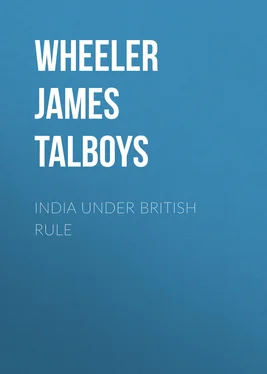War with France, 1745.
§10. In 1745 news reached India that war had been declared between Great Britain and France. This was alarming news for the British traders at Madras, as the French had established a flourishing town and settlement at Pondicherry, on the coast of Coromandel, about a hundred miles to the south of Madras, and a collision might be expected at any moment between the two settlements. Moreover, the Governor of Pondicherry was a certain M. Dupleix, a Frenchman of large capacity and restless ambition, who hated the British with all the ardour of the typical Frenchman of the eighteenth century. The same year a British fleet appeared off the coast of Coromandel and threatened Pondicherry; but the Nawab of the Carnatic declared that he would have no wars between European nations within his territories, and the British fleet sailed away.
Madras captured, 1746.
In 1746 a French fleet appeared off Madras, but the Nawab was not inclined to interfere; he had, in fact, been bought over by M. Dupleix, the French Governor of Pondicherry. The French bombarded Fort St. George; the native inhabitants fled from Madras; and the British inhabitants were carried in triumph to Pondicherry as prisoners of war.
French defeat the Mogul army.
The Nawab of the Carnatic affected to be very angry at this bombardment of Madras. He demanded that the settlement should be transferred to his authority, and sent an army of 10,000 Moguls to take possession of the town and fortress. To his utter amazement the army of 10,000 Moguls was utterly routed by a battalion of 800 Frenchmen. From that day it was felt throughout Southern India that no Mogul army could stand against the rapid firing of disciplined Europeans. In 1748 the war between Great Britain and France was over for a while, and Madras was restored to the British.
Brilliant success of Dupleix.
Later on, the death of the Nizam of the Deccan threw the whole country into confusion. Rival kinsmen began to fight for the throne of the province without any reference to the Great Mogul. Dupleix plunged at once into the fray. He saw that a French force might turn the scale of victory, and he moved a French army, under the command of Bussy, to help a victorious candidate as occasion served, without the slightest regard to the rightness or wrongness of his claim. In 1751 he had realised his dream of ambition. He had placed a Nizam on the throne at Hyderabad, and he was rewarded with the cession of a territory stretching 600 miles along the coast, for the maintenance of a French standing army. To crown all, he induced the Nizam to appoint him Nawab of the Carnatic; and, in spite of Dupleix being a Frenchman and a Catholic, the appointment was actually made under the seal of the Great Mogul. Meanwhile, the British had supported the claim of a Mogul prince named Mohammed Ali to the throne of the Carnatic, but had been circumvented at every turn, and were now called upon to acknowledge the superior authority of their bitter enemy Dupleix.
Triumph of Robert Clive.
British rule in Southern India was at its last gasp. If Dupleix could only have got hold of Mohammed Ali, he might have been master of the Carnatic; Madras might have been a French settlement, and a French Governor and Council might have taken the place of the British in Fort St. George. As it was, Mohammed Ali was very nearly surrendering. He had fled away to seek the help of the Hindu Rajas of the south, and was being closely besieged by the French in the city of Trichinopoly, 180 miles to the south of Arcot. At this crisis Robert Clive saved the East India Company. He left Madras with a small force, and after a march of seventy miles into the interior, threw himself into the city of Arcot, the capital of the Carnatic, where the Nawabs of the Carnatic had held their court for more than half a century. The native garrison fled at his approach, and the inhabitants, numbering 100,000, offered no resistance. The French were aghast at hearing that the capital of the Carnatic was in the hands of the British. They despatched a large force from Trichinopoly, but failed to recover Arcot. In the end they raised the siege of Trichinopoly, and Mohammed Ali was delivered out of their hands and placed by the British in possession of the Carnatic, to the exclusion of Dupleix and ruin of his ambitious schemes.
Tragedy at Calcutta, 1756.
British and French were now anxious for peace, and agreed to make Dupleix their scapegoat. They threw the whole blame of the war upon the unfortunate Frenchman, who returned to France and died in poverty. In 1755 a treaty was patched up at Pondicherry, but was never executed. In 1756, on the eve of the Seven Years' War, terrible news arrived from Bengal. The Nawab had captured the settlement at Calcutta; and a hundred and twenty-three English prisoners had been thrust into a barrack cell, and perished most miserably of heat and suffocation.
Threats of the Nawab of Bengal.
§11. The tragedy was appalling, but the causes were intelligible. About the beginning of the eighteenth century, a Nawab of Bengal, Behar, and Orissa, territories considerably larger than the United Kingdom, had removed his capital from Dacca to Murshedabad, about a hundred miles due north of Calcutta. Here he founded a dynasty, which reigned in peace for some forty years. About 1742 a usurper seized the throne of Murshedabad, and reigned as Nawab. He died of extreme old age in April, 1756, and was succeeded by a grandson, a young man timid and suspicious, surrounded by foes eager to take his life and throne. The new Nawab heard that Governor Drake was sheltering one of his enemies at Calcutta, and strengthening the fortifications; and he ordered the British to surrender the refugee and stop further defences. Governor Drake replied that he knew nothing of any enemies of the Nawab; that he was ready to obey the Nawab in all things; and that he was repairing the defences on the river to prevent being surprised by the French, as Madras had been surprised ten years before. The Nawab was in a fury at this message, and set off for Calcutta in the heats of June with an army of fifty thousand men.
Defences at Calcutta.
For half a century the British had paid little or no attention to their defences. Fort William had been deemed a sufficient protection on the side of the river, and on the land side the native inhabitants had begun to dig a ditch as a defence against the Mahratta horsemen; but the Mahrattas were paid chout to go away, and the ditch was never finished. The Europeans dwelt in houses and gardens along the bank of the river Hughly, on either side of Fort William; and an English Church, the Mayor's Court and some other buildings, covered Fort William on the land side. The native quarter, including a large bazaar, adjoined the Mahratta ditch, and avenues of trees led from the native quarter to Fort William and the European buildings.
Neglected precautions.
Had Governor Drake or any member of his Council possessed a spark of military genius, they might have held Fort William against the Nawab in spite of his superior numbers. There was a garrison of two hundred European soldiers in the Fort. The European residents should have abandoned their houses on the river, and repaired to the Fort with their wives and children. The neighbouring buildings should have been demolished to prevent the Nawab's troops from approaching under cover. The enemy should have been harassed with shells all day and sallies all night, until the Nawab raised the siege. Moreover, the beginning of the south-west monsoon was daily expected. With it would come the ships of the season from Europe. Could the besieged have held out for ten days, they might have been rescued by the ships, just as Charnock and the factors were carried away from Hughly some seventy years before.
Weak preparations.
Whilst the Nawab's army was approaching Calcutta, the native population were flying en masse to the neighbouring villages. There was also a large population of Portuguese half-castes, which should have been left to do the same, as they would have been in no manner of danger. Unfortunately, two thousand of these black women and children were admitted into the Fort, and the overcrowding and confusion were fatal. Meanwhile, batteries and breastworks were constructed in the avenues leading to the Fort, in the wild hope of protecting the whole European quarter; but they were too far away to be supported by reinforcements from the European garrison.
Читать дальше












